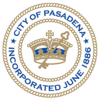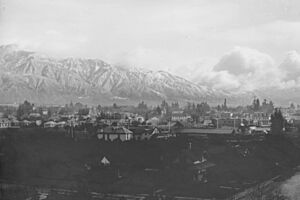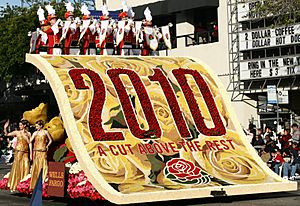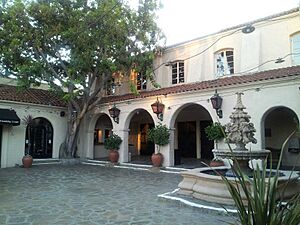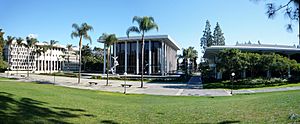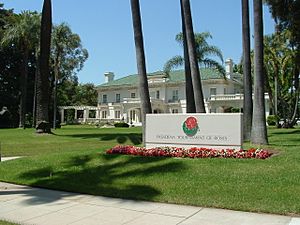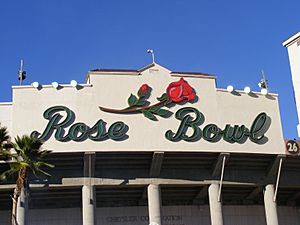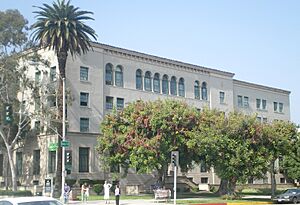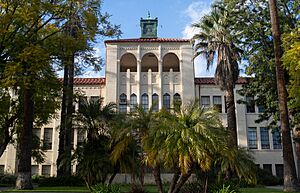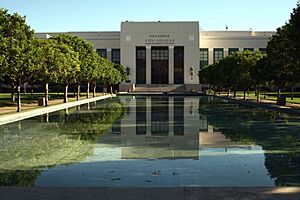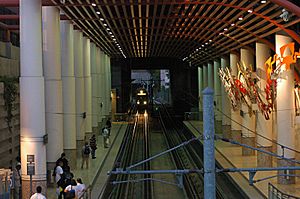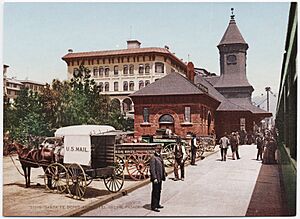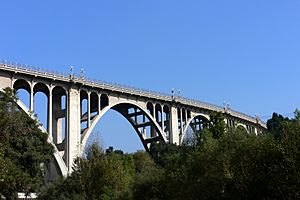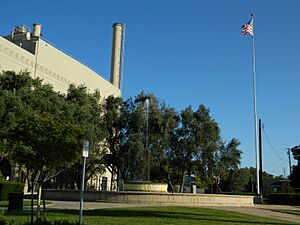Pasadena, California facts for kids
Quick facts for kids
Pasadena, California
|
|||
|---|---|---|---|
|
|||
| Nickname(s):
City of Roses, Crown City, Rose Town
|
|||
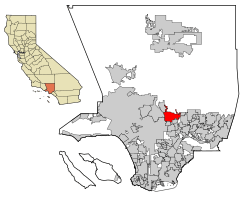
Location in Los Angeles County and the State of California
|
|||
| Country | United States | ||
| State | California | ||
| County | Los Angeles | ||
| Incorporated | June 19, 1886 | ||
| Named for | "Valley" in the Ojibwe language, chosen by American settlers | ||
| Government | |||
| • Type | City council/manager | ||
| Area | |||
| • Total | 23.11 sq mi (59.84 km2) | ||
| • Land | 22.96 sq mi (59.47 km2) | ||
| • Water | 0.14 sq mi (0.37 km2) 0.68% | ||
| Elevation | 863 ft (263 m) | ||
| Population
(2020)
|
|||
| • Total | 138,699 | ||
| • Rank | 9th in Los Angeles County 45th in California 214th in the U. S. |
||
| • Density | 6,141.5/sq mi (2,371.24/km2) | ||
| Demonym(s) | Pasadenan | ||
| Time zone | UTC−8 (Pacific) | ||
| • Summer (DST) | UTC−7 (PDT) | ||
| ZIP Codes |
91101–91110, 91114–91118, 91121, 91123–91126, 91129, 91182, 91184, 91185, 91188, 91189, 91199
|
||
| Area code | 213/323, 626 | ||
| FIPS code | 06-56000 | ||
| GNIS feature IDs | 1664804, 2411379 | ||
| Flower | Rose | ||
Pasadena is a city in Los Angeles County, California, United States. It is about 11 miles (18 km) northeast of downtown Los Angeles. Pasadena is the biggest city and main cultural center of the San Gabriel Valley. The area known as Old Pasadena is the city's original shopping district.
In 2020, Pasadena had a population of 138,699 people. This makes it the 45th largest city in California. It is also the ninth-largest city in Los Angeles County. Pasadena became an official city on June 19, 1886. It was one of the first cities to be incorporated in Los Angeles County.
Pasadena is famous for hosting the yearly Rose Bowl football game. It also hosts the Tournament of Roses Parade. The city is home to many important places for science, education, and culture. These include the California Institute of Technology (Caltech) and the Norton Simon Museum.
Contents
History of Pasadena
Who lived in Pasadena first?
The first people known to live in the Pasadena area were the Hahamog-na tribe. They were a part of the Tongva Nation. They spoke the Tongva language, which is part of the Uto-Aztecan language family. Native Americans had lived in the Los Angeles Basin for thousands of years.
The name "Pasadena" means "valley" in the language of the Ojibwe tribe. This tribe is not from the California area. American settlers from Indiana chose the name when they moved here.
The Spanish and Mexican Eras
Spanish explorers first came to the Los Angeles Basin in the 1770s. They built the San Gabriel Mission. They called the local Tongva people "Gabrielino Indians" after the mission. Today, several groups of Tongva people still live in the Los Angeles area.
In 1821, Mexico became independent from Spain. California then came under Mexican rule. In 1833, the mission lands were given to private Mexican citizens. These lands were called ranchos. Today's Pasadena was split into different ranchos. One important rancho was Rancho San Pascual. It covered central Pasadena, Altadena, and South Pasadena.
Pasadena in the American Era
The last Mexican owner of Rancho del Rincon de San Pascual was Manuel Garfias. He kept his land even after the Americans took over California in 1848. He sold parts of his land to the first American settlers. One of these was Dr. Benjamin Eaton. Much of the land was bought by Benjamin Wilson. He started his Lake Vineyard property nearby.
In 1873, Dr. Daniel M. Berry from Indiana visited Wilson. Dr. Berry was looking for a place with a mild climate for his patients. Many of them had breathing problems. He found that Rancho San Pascual was perfect. To keep it a secret, he called the area "Muscat." Berry then formed a group called the Southern California Orange and Citrus Growers Association. This group bought a large part of the land. On January 31, 1874, they formed the Indiana Colony. Wilson also gave them 2,000 acres (8.1 km²) of highland property. Part of this land later became Altadena.
The Indiana Colony was a narrow strip of land. It was between the Arroyo Seco and Fair Oaks Avenue. Wilson's Lake Vineyard was on the other side of the street. After more than ten years, the two settlements joined together. They became the City of Pasadena.
Pasadena as a Resort Town
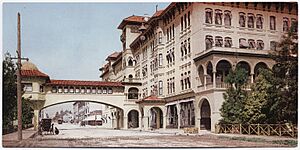
Many people from all over the country came to Pasadena. In 1887, the Atchison, Topeka and Santa Fe Railway opened a train line to Pasadena. This caused a big boom in real estate. Many tourist hotels were built in the city. Pasadena became a popular winter resort for rich people from the Eastern United States. This led to new neighborhoods and businesses. Roads and train lines also improved, connecting Pasadena to Los Angeles. By 1940, Pasadena was the eighth-largest city in California. It was seen as a "twin city" to Los Angeles.
The first big hotel in Pasadena was the Raymond, built in 1886. Other famous hotels included the Maryland Hotel and those connected to the Mount Lowe Railway. Three old hotel buildings still exist today. These are the Green Hotel, the Vista Del Arroyo (now a courthouse), and a part of the Maryland Hotel.
Pasadena is also known for its beautiful American Craftsman style homes. The famous architects Greene and Greene designed many of these. Their masterpiece, the Gamble House, is open for public tours.
Pasadena Today

World War II helped Pasadena grow. Southern California became an important area for the war in the Pacific. Many high-tech companies and scientific groups moved to the city. This trend continued after the war. A great example is NASA's Jet Propulsion Laboratory.
In the 1950s, many people from the Southern United States moved to Pasadena. This included many African-Americans from Texas and Louisiana. Pasadena also welcomed many immigrants from countries like China, Japan, Philippines, Mexico, and Armenia.
In 1969, the Pasadena Unified School District worked to end segregation in schools. A year later, the 210 Freeway was built. Its construction was debated because it meant tearing down many homes.
Downtown Pasadena saw some tough times. But many artists and creative people moved in. They took advantage of lower property costs. This led to events like the Doo Dah Parade, which started in 1976.
Geography and Climate
Pasadena's Location and Features
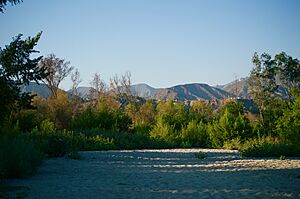
Pasadena is surrounded by the Raymond Fault line, the San Rafael Hills, and the San Gabriel Mountains. The Arroyo Seco is a major natural feature. It flows from the Angeles National Forest in the San Gabriel Mountains. The Rose Bowl stadium is located in the Arroyo Seco.
The city covers about 23.1 square miles (59.8 km²). Most of this area is land, with a small amount of water.
Pasadena's Weather
| Weather chart for Pasadena | |||||||||||||||||||||||||||||||||||||||||||||||
|---|---|---|---|---|---|---|---|---|---|---|---|---|---|---|---|---|---|---|---|---|---|---|---|---|---|---|---|---|---|---|---|---|---|---|---|---|---|---|---|---|---|---|---|---|---|---|---|
| J | F | M | A | M | J | J | A | S | O | N | D | ||||||||||||||||||||||||||||||||||||
|
4.5
68
46
|
5.2
69
46
|
3
73
48
|
1.1
76
51
|
0.5
78
54
|
0.2
84
58
|
0.1
89
62
|
0
91
63
|
0.2
90
62
|
0.8
83
56
|
1.1
75
50
|
3.3
67
45
|
||||||||||||||||||||||||||||||||||||
| temperatures in °F precipitation totals in inches |
|||||||||||||||||||||||||||||||||||||||||||||||
|
Metric conversion
|
|||||||||||||||||||||||||||||||||||||||||||||||
Pasadena has a Mediterranean climate. This means it has hot, dry summers and mild, wet winters. Its location near the San Gabriel Mountains means it gets more rain than coastal areas.
In the first few months of the year, temperatures are cool to warm. Colder days often bring heavy rain. By April, it gets warmer, and rain becomes less common. May and June are usually dry. Locals sometimes call June "June Gloom" because it can be cloudy.
Summers, from July to October, can be very hot. It rarely rains during these months. Sometimes, the remains of hurricanes bring rain. It's possible to go six months without any measurable rain. The hottest days usually happen in September.
By late October, temperatures drop. In November, Pacific storms return, bringing more rain and cooler weather. But sometimes, Santa Ana winds can bring heat, strong winds, and increase wildfire risk. In December, temperatures often drop into the 40s (around 5-10°C).
Pasadena gets about 20 inches (500 mm) of rain each year. This is more than nearby Los Angeles because of the mountains. Snow sometimes falls in Pasadena. The heaviest snowfall was 8 inches (20 cm) on January 11, 1949. The most recent snowfall was 1 inch (2.5 cm) on February 21, 2019.
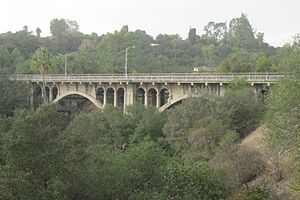
In late 2011, a major windstorm hit Pasadena. Strong Santa Ana winds caused a lot of damage. Trees were knocked down, and buildings were damaged.
Population and People
| Historical population | |||
|---|---|---|---|
| Census | Pop. | %± | |
| 1880 | 391 | — | |
| 1890 | 4,882 | 1,148.6% | |
| 1900 | 9,117 | 86.7% | |
| 1910 | 30,291 | 232.2% | |
| 1920 | 45,354 | 49.7% | |
| 1930 | 76,086 | 67.8% | |
| 1940 | 81,864 | 7.6% | |
| 1950 | 104,577 | 27.7% | |
| 1960 | 116,407 | 11.3% | |
| 1970 | 112,951 | −3.0% | |
| 1980 | 118,072 | 4.5% | |
| 1990 | 131,591 | 11.4% | |
| 2000 | 133,936 | 1.8% | |
| 2010 | 137,122 | 2.4% | |
| 2020 | 138,699 | 1.2% | |
| U.S. Decennial Census | |||
Pasadena is a diverse city with people from many backgrounds. In 2020, the population was 138,699.
Who lives in Pasadena?
| Race / Ethnicity (NH = Non-Hispanic) | Pop 2000 | Pop 2010 | Pop 2020 | % 2000 | % 2010 | % 2020 |
|---|---|---|---|---|---|---|
| White alone (NH) | 52,381 | 53,135 | 50,858 | 39.11% | 38.75% | 36.67% |
| Black or African American alone (NH) | 18,711 | 13,912 | 10,795 | 13.97% | 10.15% | 7.78% |
| Native American or Alaska Native alone (NH) | 324 | 211 | 201 | 0.24% | 0.15% | 0.14% |
| Asian alone (NH) | 13,253 | 19,293 | 24,149 | 9.90% | 14.07% | 17.41% |
| Pacific Islander alone (NH) | 104 | 106 | 130 | 0.08% | 0.08% | 0.09% |
| Other race alone (NH) | 302 | 434 | 835 | 0.23% | 0.32% | 0.60% |
| Mixed race or Multiracial (NH) | 4,127 | 3,857 | 5,989 | 3.08% | 2.81% | 4.32% |
| Hispanic or Latino (any race) | 44,734 | 46,174 | 45,742 | 33.40% | 33.67% | 32.98% |
| Total | 133,936 | 137,122 | 138,699 | 100.00% | 100.00% | 100.00% |
In 2010, Pasadena had 137,122 people. About 55.8% were White, 10.7% were African American, and 14.3% were Asian. About 33.7% of residents were Hispanic or Latino.
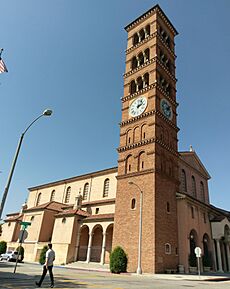
There were 55,270 households in Pasadena. About 26.2% of these had children under 18. The average household size was 2.42 people. The median age in Pasadena was 37.2 years.
In 2010, the median household income was $69,302. About 13.2% of the population lived below the poverty line. By 2019, the median household income had risen to $83,068.
Economy and Jobs

Pasadena has a lively economy with many shops, restaurants, and businesses.
Shopping and Entertainment
Old Town Pasadena is a popular area downtown. It has many shops, restaurants, and entertainment spots. "One Colorado" is a special area with old buildings that have been updated for new stores and places to eat. This helped bring new life to Old Town on Colorado Boulevard.
Paseo Colorado is an outdoor mall. It has stores and a movie theater. Another shopping area is in the South Lake Avenue neighborhood. Here, you can find a Macy's department store in a historic building.
The Rose Bowl Flea Market is a huge event. Thousands of sellers and visitors come to the Rose Bowl grounds. You can find everything from old antiques to vintage clothes. This market has been held every second Sunday of the month since 1967.
Major Employers in Pasadena
Pasadena is home to many large employers. These include:
- Jet Propulsion Laboratory (JPL)
- Kaiser Permanente
- California Institute of Technology (Caltech)
- Huntington Memorial Hospital
- Pasadena City College
- Pasadena Unified School District
- City of Pasadena
- Art Center College of Design
Other companies based in Pasadena include Idealab, Inter-Con Security, and Wetzel's Pretzels.
Arts and Culture
Tournament of Roses Parade
Pasadena is famous for the Tournament of Roses Parade. It happens every year on January 1st (or January 2nd if the 1st is a Sunday). The first parade was in 1890. It was started by the Valley Hunt Club. They wanted to show the world how beautiful Pasadena was, even in winter.
By 1895, the parade was so big that the Tournament of Roses Association was formed to organize it. The Rose Parade is known for its amazing floats, marching bands, and horse units. Every part of the floats must be covered with natural materials like flowers, leaves, or seeds. Volunteers work hard for days to decorate the floats. The parade route is over 5 miles (8 km) long. Over a million people watch it, many camping out overnight to get the best spots.
The Rose Parade also has a Rose Court. These are local high school students who are chosen to represent the city. One student is chosen as the Rose Queen, and others are Rose Princesses. They visit local businesses and communities to help promote the area.
Rose Bowl Game
The Rose Bowl stadium is a National Historic Landmark. It hosts the famous college football game, the Rose Bowl Game, every New Year's Day. In 1902, a football game was added to the Tournament of Roses events. This was the first college football game played on New Year's Day. It's known as "The Grandaddy of Them All."
The game grew so popular that a new stadium was built in 1923. It was named "The Rose Bowl." The Rose Bowl also hosts yearly Fourth of July fireworks shows.
Performing Arts in Pasadena
The Pasadena Playhouse is the State Theater of California. It has been putting on shows for over 100 years. In 1937, it became the only theater in the U.S. to perform all of Shakespeare's plays. Today, it is known for its creative productions.
The Pasadena Symphony performs several concerts each year. The Pasadena Pops plays at the Los Angeles County Arboretum and Botanic Garden. The Civic Center also hosts traveling Broadway shows.
Boston Court Performing Arts Center opened in 2003. It has a theater company that puts on four plays a year. They also host many music concerts. The Friends of the Levitt organization offers free summer concerts in Memorial Park.
Caltech's Beckman Auditorium also hosts many performances, lectures, and films. Twice a year, Pasadena's cultural places open their doors for free during ArtNight Pasadena. This event lets the public enjoy art, history, and music. This has grown into the yearly PasadenART Weekend, a three-day event with art, music, and performances.
The Ambassador Auditorium was built for religious services and public concerts. In 2007, the Pasadena band Ozma made an album called Pasadena as a tribute to the city.
The 1960s song "The Little Old Lady from Pasadena" made fun of the idea that Pasadena was full of old, quirky people. The song by Jan and Dean talks about an old lady who drives a fast car on Colorado Boulevard.
Visual Arts and Museums
Many famous artists lived in Pasadena in the early 1900s. The city became a center for visual arts.
Pasadena has several art museums and galleries. The Norton Simon Museum has European paintings, sculptures, and tapestries. It also has art from Southern Asia.
The Pasadena Museum of History works to save and share Pasadena's rich history. It has gardens, a history center, and the Fenyes Mansion, a beautiful old home from 1906.
The Pacific Asia Museum shows art from many Asian countries. The Armory Center for the Arts has art shows and offers art classes for all ages. The Huntington Library and Botanical Gardens is nearby in San Marino. It has painting and sculpture galleries. The Kidspace Children's Museum is in Brookside Park.
Pasadena's Unique Neighborhoods
Bungalow Heaven
Bungalow Heaven is a neighborhood with 800 small Craftsman-style homes. These homes were built between 1900 and 1930. Many are still lived in today. The area became a landmark district in 1989. Historic home tours are held every year. The famous architects Greene and Greene built some of their Japanese-inspired bungalows in Pasadena. Their success influenced the style of homes in Bungalow Heaven.
Orange Grove Boulevard
The Norton Simon Museum is at the start of the Rose Parade route on Orange Grove Boulevard. You can see it clearly during the parade on TV.
Orange Grove Boulevard is a fancy residential area in Pasadena. It has been home to rich and famous people since the early 1900s. Because of its many grand mansions, it was called "Millionaire's Row."
Historical Estates
The home of William Wrigley Jr., who made Wrigley's chewing gum, was given to the city of Pasadena in 1958. His family wanted it to be the permanent headquarters for the Rose Parade. This beautiful home, called the Tournament House, still serves this purpose today.
The Gamble House is a masterpiece of American Craftsman architecture. It was built in 1908 by architects Charles and Henry Greene. It is open to the public as a museum. The Gamble House is a California Historical Landmark and a National Historic Landmark. Students from the University of Southern California School of Architecture live in the house each year.
Sports and Recreation
Rose Bowl Stadium
The Rose Bowl stadium is not just for the New Year's Day game. It is also the home field for the UCLA Bruins college football team. It has hosted five Super Bowls and many other important football games.
The stadium has also hosted major soccer games. These include the 1984 Summer Olympics soccer final, the 1994 FIFA World Cup final, and the 1999 FIFA Women's World Cup final. The Los Angeles Galaxy soccer team played here from 1996 to 2003. Many concerts and other events are also held at the Rose Bowl.
Aquatic and Tennis Centers
The Rose Bowl Aquatics Center is right next to the Rose Bowl Stadium. This pool hosted the final practices for the 2000 US Olympic swimming and diving team. In 2008, it held the U.S. National Diving Championships.
The Rose Bowl Tennis Center is operated by the city of Pasadena. It is located south of the Rose Bowl Stadium.
Professional Futsal
Pasadena also has a professional futsal team called the Pasadena Purple Cows. Futsal is a type of indoor soccer.
Education in Pasadena
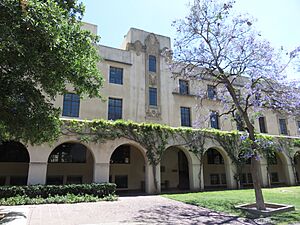
Pasadena is home to many excellent schools and universities.
Higher Education
The California Institute of Technology (Caltech) is in southern Pasadena. It is one of the world's top universities for science and engineering. The Jet Propulsion Laboratory (JPL), which works for NASA, is also in Pasadena and managed by Caltech. As of 2022, Caltech has had 46 Nobel Prize winners.
The Kaiser Permanente Bernard J. Tyson School of Medicine opened in 2020. It is a very competitive medical school. Fuller Theological Seminary is one of the largest seminaries in the world.
The Le Cordon Bleu College of Culinary Arts has two campuses in Pasadena. Pacific Oaks College is next to the historic Gamble House. Providence Christian College is on the north side of Pasadena.
Art Center College of Design has two campuses. It offers many programs in visual and applied arts. The Los Angeles Music Academy College of Music trains students in contemporary music.
Pasadena City College is a community college founded in 1924. It is on Colorado Boulevard. For many years, the Rose Parade Queen's court was chosen from its students.
K-12 Schools
The Pasadena Unified School District covers Pasadena, Altadena, and Sierra Madre. It has many elementary, middle, and high schools. There are also many private schools in the city.
Private elementary schools include Walden, Mayfield Junior School, and Polytechnic School. Private high schools include Mayfield Senior School and La Salle High School.
University of the People is the world's first tuition-free online university. It is located on Lake Avenue.
Pasadena Public Library
Pasadena had a public library even before it became a city. The Pasadena Central Library was built in 1927. It is a large library and has been used as a filming location for movies like Matilda and Legally Blonde. The library is also listed on the National Register of Historic Places.
Media and Entertainment
Civic Auditorium
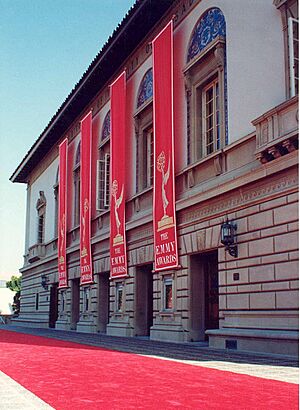
The Civic Auditorium is on Green Street. It is a large venue used for many events. The TV show American Idol films its "Hollywood Week" here. It was also the location for the Miss Teen USA 2007 pageant. The auditorium hosted the annual Emmy Awards ceremony for 20 years. Many high school graduations are also held here.
Television and Radio
Pasadena is the setting for many TV shows. These include The Big Bang Theory, Brothers & Sisters, and Disney Channel's Dog with a Blog.
Pasadena has local television channels managed by Pasadena Community Access Corporation. Local news for Pasadena is produced by Crown City News. ABC's show Splash was filmed at the Rose Bowl Aquatics Center.
Pasadena has a notable history in radio. Today, the main radio station is KPCC at 89.3 FM. This public radio station plays shows from National Public Radio and also provides local news.
Newspapers and Magazines
Pasadena's oldest newspaper is the Pasadena Star-News, which started in 1884. The Pasadena Journal is a weekly paper that focuses on the Black community. Pasadena Now is a community news website. Pasadena Weekly is another local newspaper.
City Services and Transportation
Public Transit and Trains
Pasadena has a light rail system called the A Line. It connects Pasadena to Long Beach and Azusa. There are six A Line stations in Pasadena. The line used to be called the Gold Line. It was extended east in 2016.
Pasadena also has various bus services. Pasadena Transit serves only the city. Other bus services like Foothill Transit and Metro Local also serve Pasadena.
Pasadena used to have a train station called the Santa Fe Depot. It was a busy station, and many celebrities used it to avoid the media in Los Angeles. Passenger train service ended in 1994. The old depot is now a restaurant near the Del Mar station.
Airports
Hollywood Burbank Airport is a regional airport near Pasadena. It is owned and operated by the cities of Burbank, Glendale, and Pasadena. For bigger flights, people use Los Angeles International Airport (LAX) or Ontario International Airport.
Freeways and Highways
Four freeways run through Pasadena. The most important is the Foothill Freeway (I-210). It connects Pasadena to San Fernando and San Bernardino.

The Ventura Freeway (SR 134) starts in Pasadena and goes west. It connects to the Hollywood Burbank Airport and the San Fernando Valley.
A part of the Long Beach Freeway (SR 710 in Pasadena) is in Pasadena. This freeway was meant to connect Long Beach to Pasadena. However, a section called the "South Pasadena Gap" was never finished due to local opposition. The money for this gap will now be used for local road improvements.
The Arroyo Seco Parkway (SR 110), also known as the Pasadena Freeway, was California's first freeway. It connects Los Angeles with Pasadena.
Historic U.S. Route 66 also ran through Pasadena until 1964.
Water and Power
Pasadena has its own Water and Power Department (PWP). It provides water and electricity to the city and nearby areas. PWP has operated the Glenarm Power Plant for over 110 years.
The city started its own power department in 1906. It began offering power to businesses in 1908. In 1912, the Water Department was created. In 1967, the two departments joined to become Pasadena Water and Power.
Wildlife in Pasadena
Pasadena has many wild parrots that are not native to the area. There are at least six different types of parrots. Some people enjoy them, while others find them noisy. A common story is that they escaped from a pet store that burned down in 1959.
Sister Cities
Pasadena has six sister cities around the world:
 Ludwigshafen, Germany (since 1948)
Ludwigshafen, Germany (since 1948) Mishima, Japan (since 1957)
Mishima, Japan (since 1957) Järvenpää, Finland (since 1983)
Järvenpää, Finland (since 1983) Vanadzor, Armenia (since 1991)
Vanadzor, Armenia (since 1991) Xicheng District, Beijing, China (since 1999)
Xicheng District, Beijing, China (since 1999) Dakar-Plateau, Senegal (since 2019)
Dakar-Plateau, Senegal (since 2019)
Pasadena also has "Friendship Cities" in Japan and South Korea.
Images for kids
See also
 In Spanish: Pasadena (California) para niños
In Spanish: Pasadena (California) para niños








